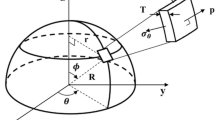Abstract
In this paper, a small specimen method to evaluate creep properties of materials is proposed. It is a modified form of Shear Punch Creep Test that has a small fillet at the end of the punch that is named Fillet Punch Creep Test (FPCT) for simplicity. The activation energy and the Larson-Miller constant of Al2024-T851 are determined using FPCT. The FPCT results closely match the results of Uniaxial Creep Test using the Larson-Miller parameter to convert shear stress of FPCT to equivalent normal stress of Uniaxial Creep Test. The experimental results show the validity of FPCT to evaluate the creep properties of materials.















Similar content being viewed by others
References
ASTM (2013) ASTM E8/E8M – 13a
Hyde CJ, Hyde TH, Sun W, Nardone S, Bruycker ED (2013) Small ring testing of a creep resistant material. Mater Sci Eng A 586:358–366. doi:10.1016/j.msea.2013.07.081
Hyde TH, Sun W, Becker AA (1996) Analysis of the impression creep test method using a rectangular indenter for determining the creep properties in welds. Int J Mech Sci 38:1089–1102. doi:10.1016/0020-7403(95)00112-3
Kabirian F, Mahmudi R (2009) Effects of rare earth element additions on the impression creep behavior of AZ91 magnesium alloy. Metall Mater Trans A 40:2190–2201. doi:10.1007/s11661-009-9905-2
Manhan MP, Argon AS, Harling OK (1981) The development of a minioturized disk bend test for the determination of post-irradiation mechanical properties. J Nucl Mater 103 &104:1545–1550. doi:10.1016/0022-3115(82)90820-0
Shibli IA, Holdsworth SR (2005) Creep and fracture in high temperature components – design and life assessment issues. DESTech Publications, London, pp 336–349
CEN (2007) Workshop Agreement, CWA 15627, Small Punch Test Method for Metallic Materials, CEN, Brussels, Belgium, 6–39
Nobakhti H, Soltani N (2016) Evaluating small punch test as accelerated creep test using larson-miller parameter. Exp Tech 40:645–650. doi:10.1007/s40799-016-0067-z
Alizadeh R, Mahmudi R, Esfandyarpour MJ (2011) Shear punch creep test: a novel localized method for evaluating creep properties. Scr Mater 64:442–445. doi:10.1016/j.scriptamat.2010.11.007
Karthik V, Visweswaran P, Vijayraghavan A, Kasiviswanathan KV, Raj B (2009) Tensile–shear correlations obtained from shear punch test technique. J Nucl Mater 393:425–432. doi:10.1016/j.jnucmat.2009.06.027
Larson FR, Miller J (1952) A time-temperature relationship for rupture and creep stresses. Trans ASME 74:765–771
Kaufman JG (2008) Parametric analyses of high-temperature data for aluminum alloys. ASM Int
Sherby OD, Dorn JE (1952) Creep correlations in alpha solid solutions of aluminum. Trans ASME 194:959–964
Boresi AP, Schmidt RJ (2002) Advanced mechanics of materials, 6th edn. John Wiley & Sons, New York
Author information
Authors and Affiliations
Corresponding author
Rights and permissions
About this article
Cite this article
Moradi, A., Soltani, N. & Nobakhti, H. Fillet Punch Creep Test of Aluminum Alloy 2024-T851: A New Method to Assess Creep Properties of Materials. Exp Tech 41, 59–67 (2017). https://doi.org/10.1007/s40799-016-0160-3
Received:
Accepted:
Published:
Issue Date:
DOI: https://doi.org/10.1007/s40799-016-0160-3



